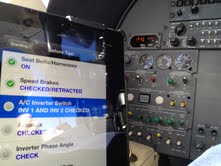 Through decades acting as a director of operations, for what it’s worth in my opinion, when procedurally used, the ipad, known as an EFB, is the greatest single contribution to cockpit safety in recent years. I must admit that this is a bold statement considering the birth of some very capable technology developments in this current decade.
Through decades acting as a director of operations, for what it’s worth in my opinion, when procedurally used, the ipad, known as an EFB, is the greatest single contribution to cockpit safety in recent years. I must admit that this is a bold statement considering the birth of some very capable technology developments in this current decade.
Five years ago I was willing to invest in these devices just for electronic aircraft checklist capabilities alone—Easy to read, crew share function to sync AFM updates, itemized checking, skip, done, and reset capabilities, all enhancing cockpit resource management, situation awareness, and minimizing checklist distractions or even omissions. Considering the number of items checked during one flight, this definitely contributes to operational efficiency, accuracy, and workload, all together enhancing safety.
Needless to say, the ipad has many more advantages than just the checklist capability.
Note above that I said when procedurally used, meaning that like any other new equipment, it must be approved, trained, and maintained.
Although I admit that the guidance set forth by the FAA is not a straight forward as it could be, I do believe it is reasonable and doable.
The FAA has set guidance for (3) Classes and (3) Types of ipad device categorization. The “Class” basically distinguishes whether the device is certified, portable, and/or attached or mounted to the airplane:
Class I A commercial off the shelf (ICOTS) non-certified device that is portable & not attached or mounted to the aicraft-it must be secured/stowed/viewable during critical flight phases (taxi, take-off, landing, or below 10,000″, other than cruises);
Class II ICOTS, but attached or mounted to the aircraft.
Class III Certified
The ”Type” basically defines the application or type of use:
Type A Ground or cruise using pre-composed information.
Type B Must be accessible in cockpit during flight & attached, displaying charts, checklists, WX, and other types of information.
Type C FAA approved application
FAA Advisory Circular 120-76A gives the guidance for approval to use the ipad/EFB in the cockpit for commercial operators. The following is a summary of the hoops to jump through, although again, I believe reasonable and necessary in order to maximize the EFB’s safe use:
- Interference testing (AC method 2); this can self-tested;
- Lithium batteries must be UL or IEC approved (apple takes care of this);
- MX procedures and documentation developed for batteries;
- Decompression Testing—needs only be representative of device type (not required by type A);
- Stowing device procedures when not mounted;
- SOP & training for device use for all phases of flight, including failure;
- No navigation referencing;
- Proving or validation period—paper backup required during this period—documentation as to the reliability to paper, etc.;
- Requires backup with at least (2) devices;
To the FAR 135 operator, the authority to use the EFB in the cockpit is issued under Operations Specifications A061. I believe any FAA Principle Operations Inspector (POI) would gladly and willingly issue this operator authority, seeing the ipad/EFB’s significant contribution to flight safety.
Jim Alexander, Director Operations






Leave A Comment